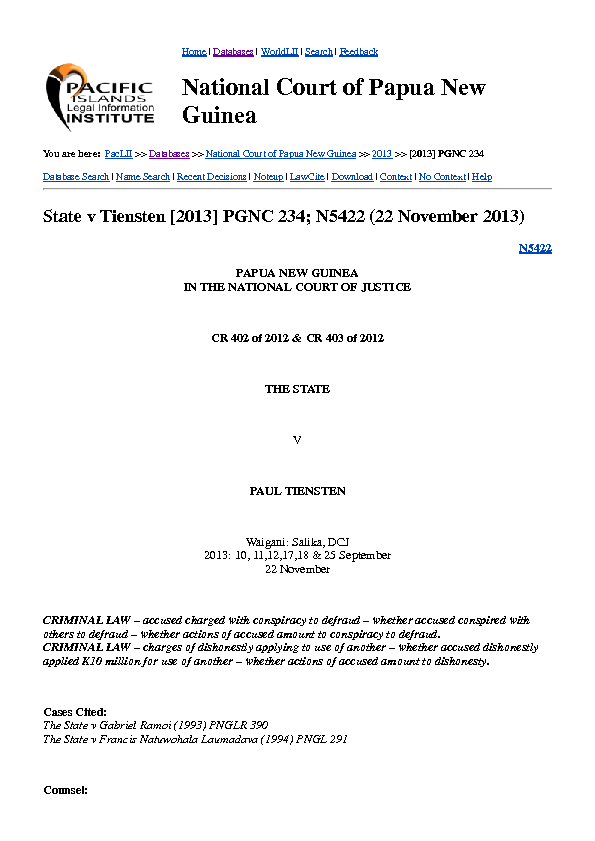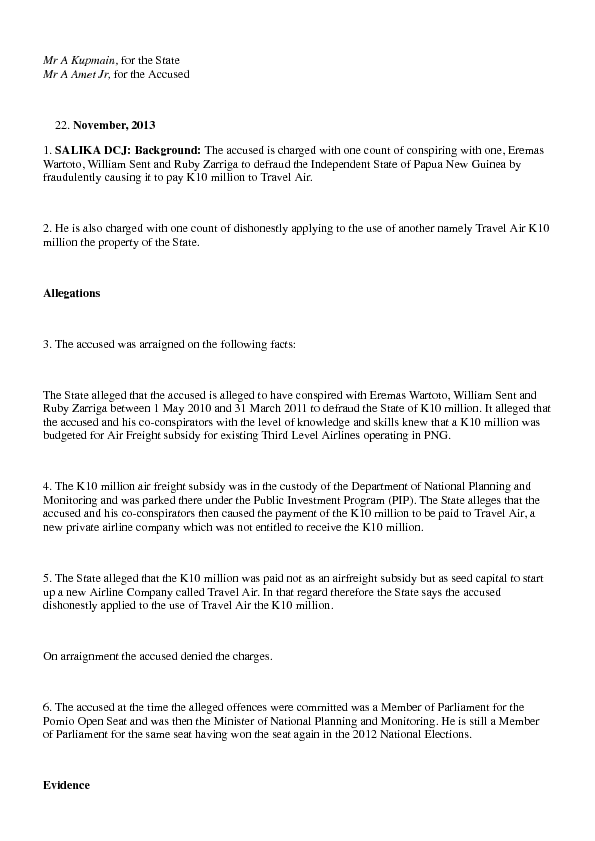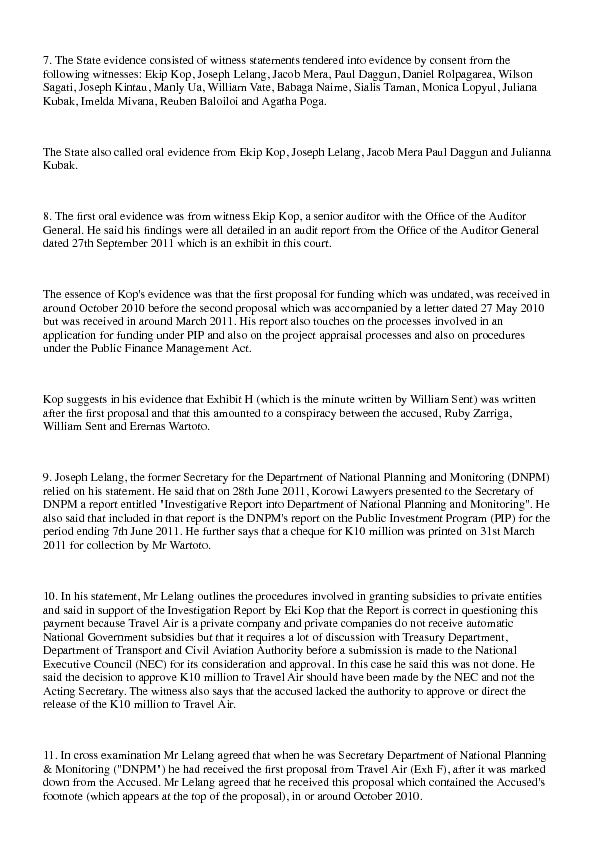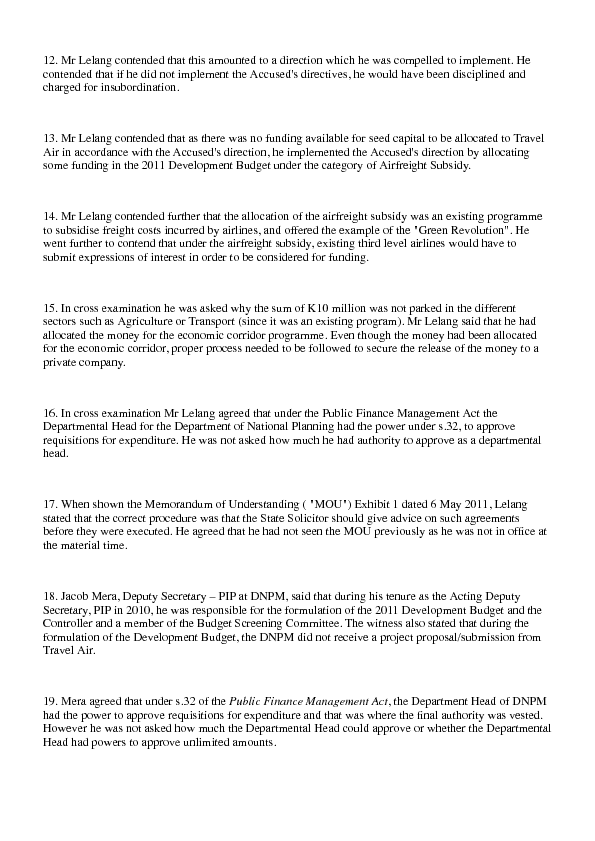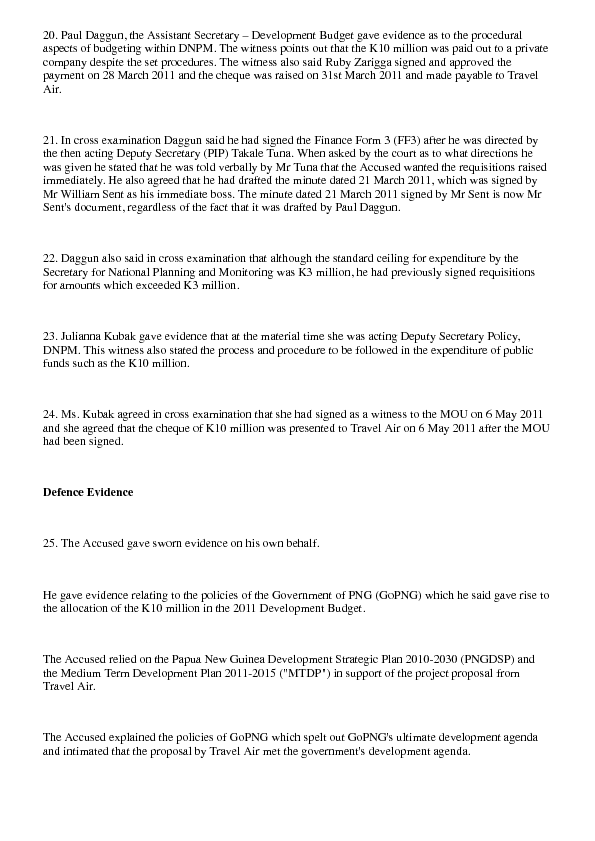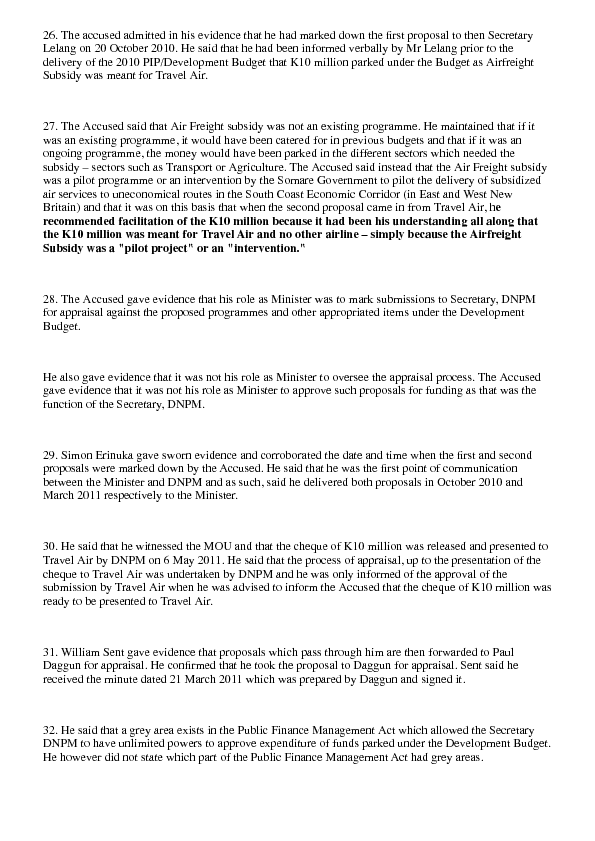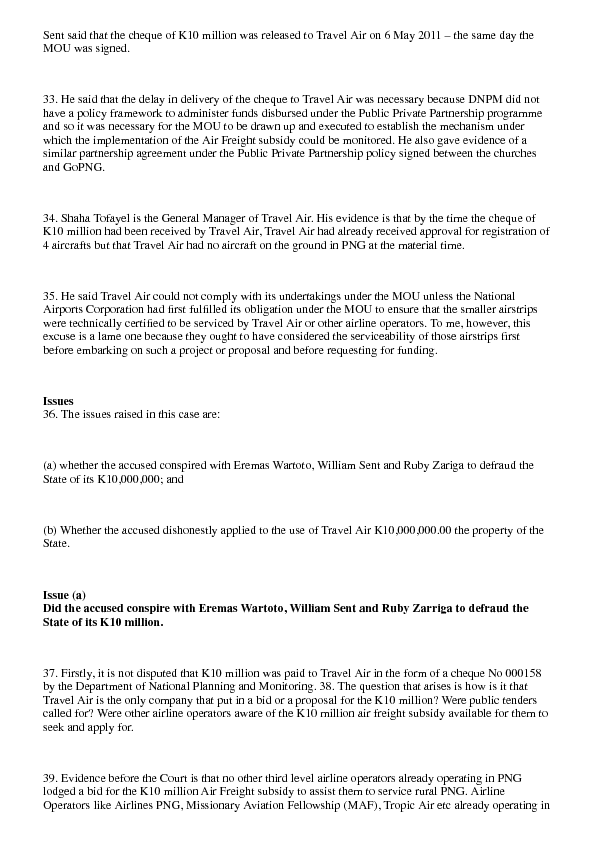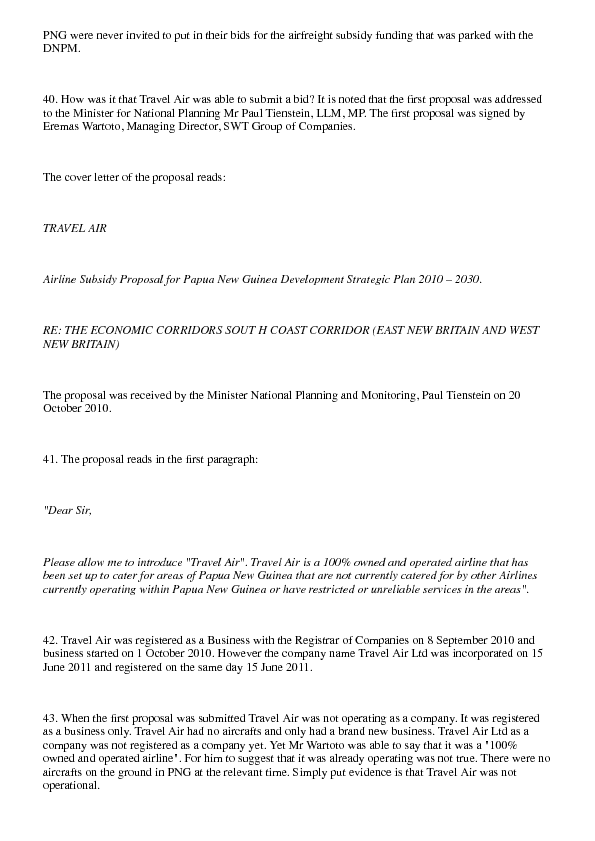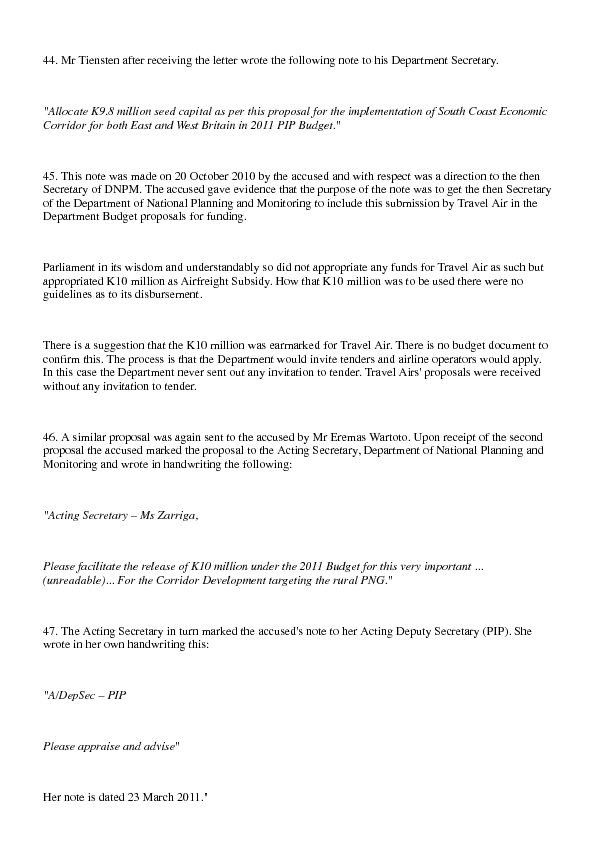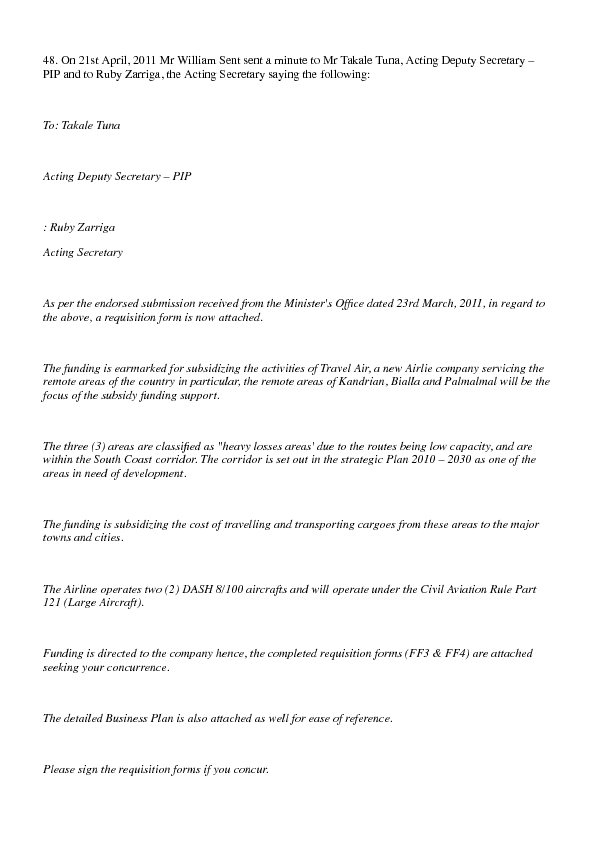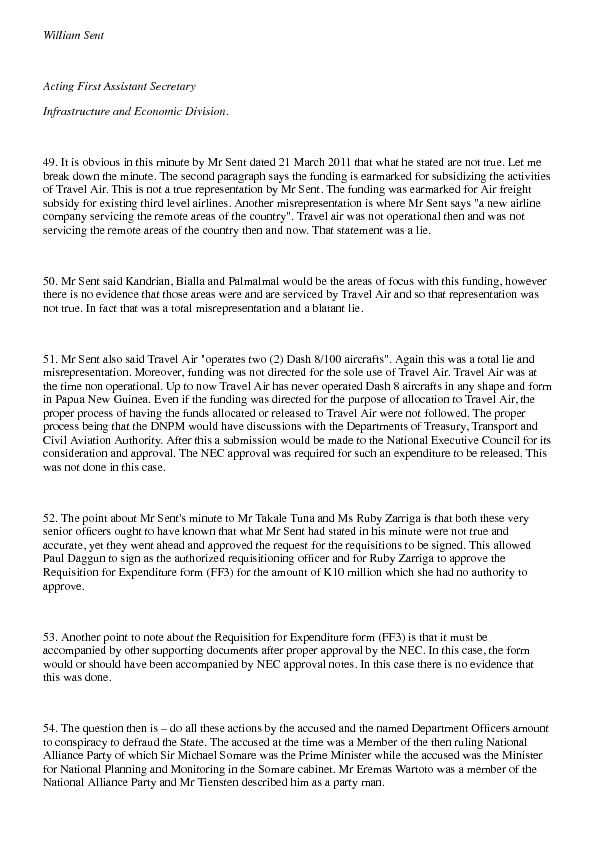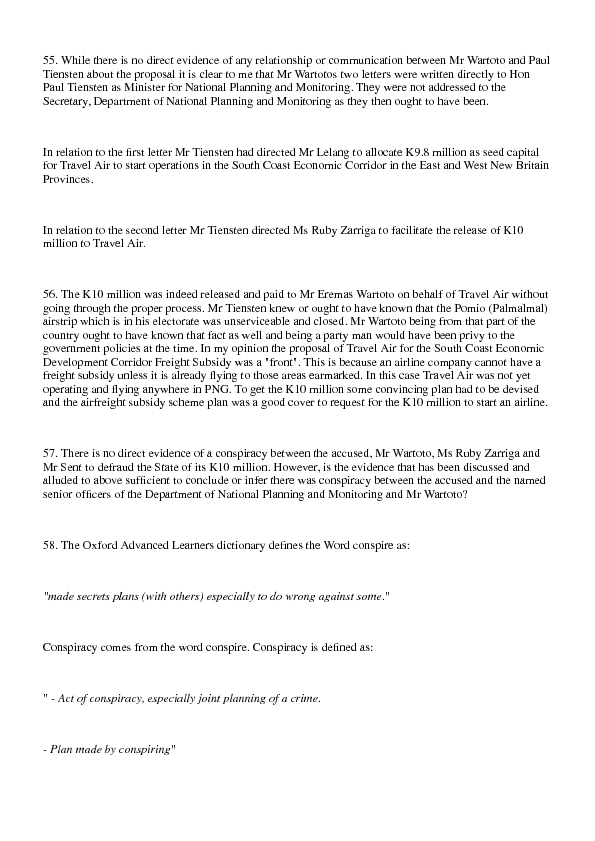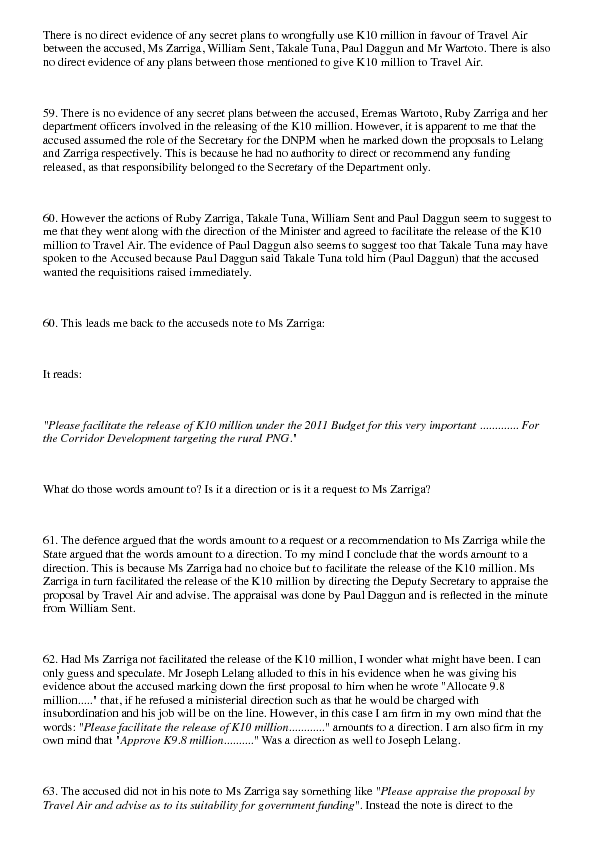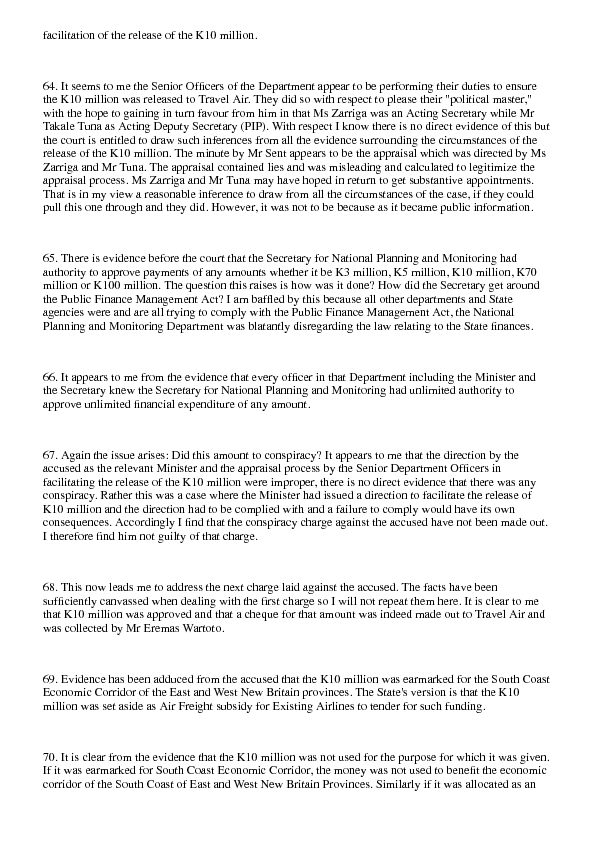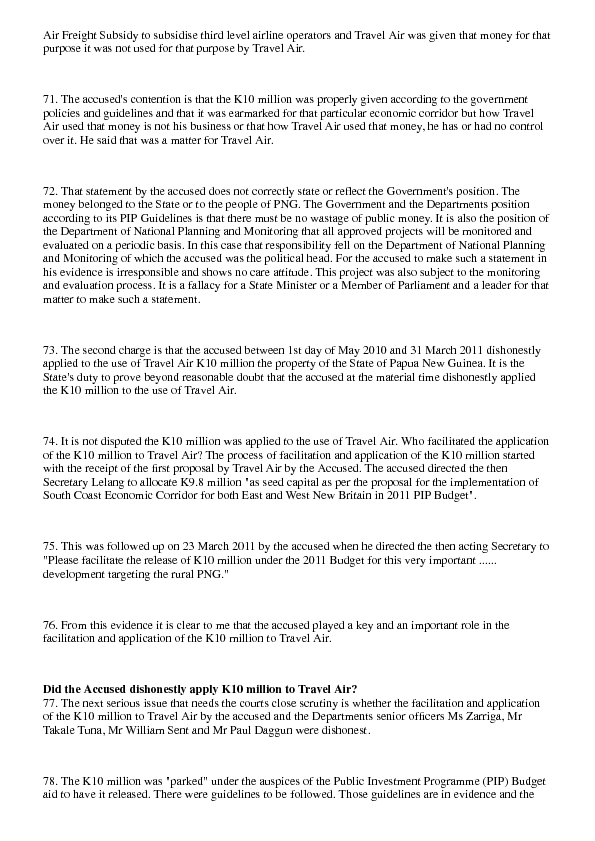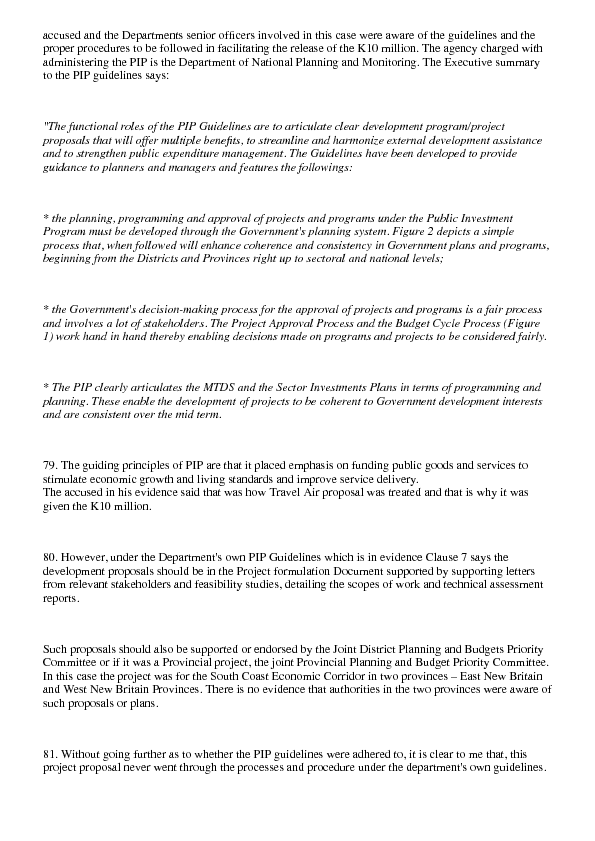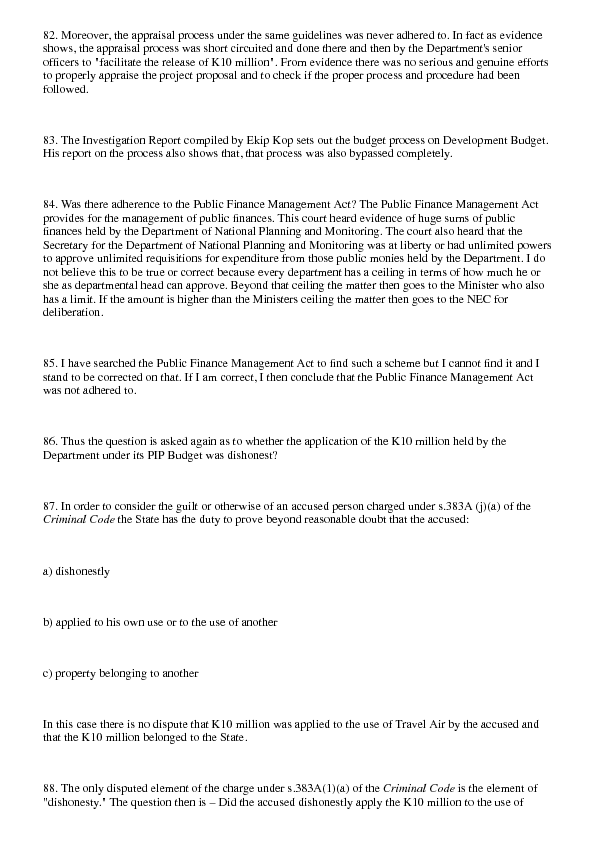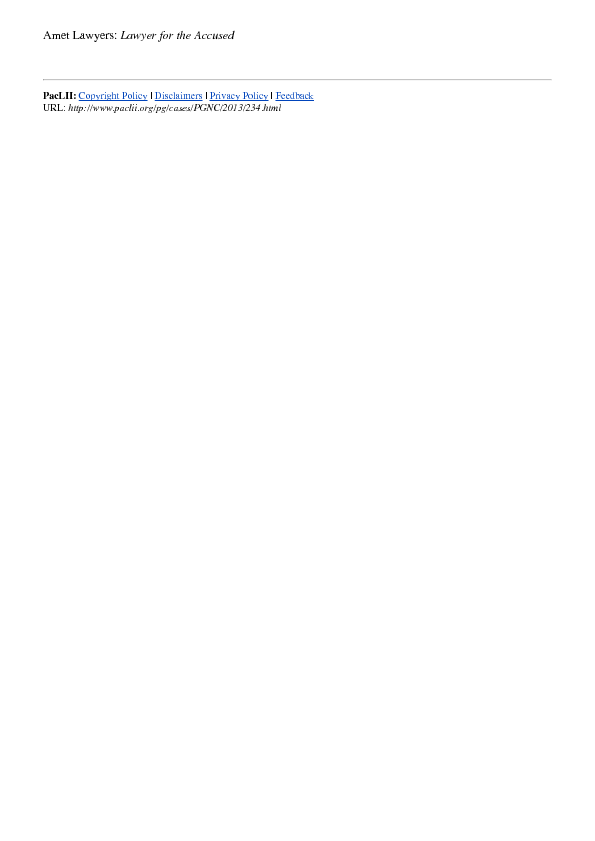State v Tiensten [2013] PGNC 234; N5422 (22 November 2013)
Mentions of people and company names in this document
It is not suggested or implied that simply because a person, company or other entity is mentioned in the documents in the database that they have broken the law or otherwise acted improperly. Read our full disclaimer
Document content
-
State v Tiensten [2013] PGNC 234; N5422 (22 November 2013) N5422
PAPUA NEW GUINEA IN THE NATIONAL COURT OF JUSTICE
CR 402 of 2012 & CR 403 of 2012
THE STATE
V
PAUL TIENSTEN
Waigani: Salika, DCJ 2013: 10, 11,12,17,18 & 25 September 22 November
CRIMINAL LAW – accused charged with conspiracy to defraud – whether accused conspired with others to defraud – whether actions of accused amount to conspiracy to defraud. CRIMINAL LAW – charges of dishonestly applying to use of another – whether accused dishonestly applied K10 million for use of another – whether actions of accused amount to dishonesty.
Cases Cited: The State v Gabriel Ramoi (1993) PNGLR 390 The State v Francis Natuwohala Laumadava (1994) PNGL 291
Counsel:
-
Page 2 of 19
-
Mr A Kupmain, for the State Mr A Amet Jr, for the Accused
22. November, 2013
1. SALIKA DCJ: Background: The accused is charged with one count of conspiring with one, Eremas Wartoto, William Sent and Ruby Zarriga to defraud the Independent State of Papua New Guinea by fraudulently causing it to pay K10 million to Travel Air.
2. He is also charged with one count of dishonestly applying to the use of another namely Travel Air K10 million the property of the State.
Allegations
3. The accused was arraigned on the following facts:
The State alleged that the accused is alleged to have conspired with Eremas Wartoto, William Sent and Ruby Zarriga between 1 May 2010 and 31 March 2011 to defraud the State of K10 million. It alleged that the accused and his co-conspirators with the level of knowledge and skills knew that a K10 million was budgeted for Air Freight subsidy for existing Third Level Airlines operating in PNG.
4. The K10 million air freight subsidy was in the custody of the Department of National Planning and Monitoring and was parked there under the Public Investment Program (PIP). The State alleges that the accused and his co-conspirators then caused the payment of the K10 million to be paid to Travel Air, a new private airline company which was not entitled to receive the K10 million.
5. The State alleged that the K10 million was paid not as an airfreight subsidy but as seed capital to start up a new Airline Company called Travel Air. In that regard therefore the State says the accused dishonestly applied to the use of Travel Air the K10 million.
On arraignment the accused denied the charges.
6. The accused at the time the alleged offences were committed was a Member of Parliament for the Pomio Open Seat and was then the Minister of National Planning and Monitoring. He is still a Member of Parliament for the same seat having won the seat again in the 2012 National Elections.
Evidence
-
Page 3 of 19
-
7. The State evidence consisted of witness statements tendered into evidence by consent from the following witnesses: Ekip Kop, Joseph Lelang, Jacob Mera, Paul Daggun, Daniel Rolpagarea, Wilson Sagati, Joseph Kintau, Manly Ua, William Vate, Babaga Naime, Sialis Taman, Monica Lopyul, Juliana Kubak, Imelda Mivana, Reuben Baloiloi and Agatha Poga.
The State also called oral evidence from Ekip Kop, Joseph Lelang, Jacob Mera Paul Daggun and Julianna Kubak.
8. The first oral evidence was from witness Ekip Kop, a senior auditor with the Office of the Auditor General. He said his findings were all detailed in an audit report from the Office of the Auditor General dated 27th September 2011 which is an exhibit in this court.
The essence of Kop’s evidence was that the first proposal for funding which was undated, was received in around October 2010 before the second proposal which was accompanied by a letter dated 27 May 2010 but was received in around March 2011. His report also touches on the processes involved in an application for funding under PIP and also on the project appraisal processes and also on procedures under the Public Finance Management Act.
Kop suggests in his evidence that Exhibit H (which is the minute written by William Sent) was written after the first proposal and that this amounted to a conspiracy between the accused, Ruby Zarriga, William Sent and Eremas Wartoto.
9. Joseph Lelang, the former Secretary for the Department of National Planning and Monitoring (DNPM) relied on his statement. He said that on 28th June 2011, Korowi Lawyers presented to the Secretary of DNPM a report entitled “Investigative Report into Department of National Planning and Monitoring”. He also said that included in that report is the DNPM’s report on the Public Investment Program (PIP) for the period ending 7th June 2011. He further says that a cheque for K10 million was printed on 31st March 2011 for collection by Mr Wartoto.
10. In his statement, Mr Lelang outlines the procedures involved in granting subsidies to private entities and said in support of the Investigation Report by Eki Kop that the Report is correct in questioning this payment because Travel Air is a private company and private companies do not receive automatic National Government subsidies but that it requires a lot of discussion with Treasury Department, Department of Transport and Civil Aviation Authority before a submission is made to the National Executive Council (NEC) for its consideration and approval. In this case he said this was not done. He said the decision to approve K10 million to Travel Air should have been made by the NEC and not the Acting Secretary. The witness also says that the accused lacked the authority to approve or direct the release of the K10 million to Travel Air.
11. In cross examination Mr Lelang agreed that when he was Secretary Department of National Planning & Monitoring (“DNPM”) he had received the first proposal from Travel Air (Exh F), after it was marked down from the Accused. Mr Lelang agreed that he received this proposal which contained the Accused’s footnote (which appears at the top of the proposal), in or around October 2010.
-
Page 4 of 19
-
12. Mr Lelang contended that this amounted to a direction which he was compelled to implement. He contended that if he did not implement the Accused’s directives, he would have been disciplined and charged for insubordination.
13. Mr Lelang contended that as there was no funding available for seed capital to be allocated to Travel Air in accordance with the Accused’s direction, he implemented the Accused’s direction by allocating some funding in the 2011 Development Budget under the category of Airfreight Subsidy.
14. Mr Lelang contended further that the allocation of the airfreight subsidy was an existing programme to subsidise freight costs incurred by airlines, and offered the example of the “Green Revolution”. He went further to contend that under the airfreight subsidy, existing third level airlines would have to submit expressions of interest in order to be considered for funding.
15. In cross examination he was asked why the sum of K10 million was not parked in the different sectors such as Agriculture or Transport (since it was an existing program). Mr Lelang said that he had allocated the money for the economic corridor programme. Even though the money had been allocated for the economic corridor, proper process needed to be followed to secure the release of the money to a private company.
16. In cross examination Mr Lelang agreed that under the Public Finance Management Act the Departmental Head for the Department of National Planning had the power under s.32, to approve requisitions for expenditure. He was not asked how much he had authority to approve as a departmental head.
17. When shown the Memorandum of Understanding ( “MOU”) Exhibit 1 dated 6 May 2011, Lelang stated that the correct procedure was that the State Solicitor should give advice on such agreements before they were executed. He agreed that he had not seen the MOU previously as he was not in office at the material time.
18. Jacob Mera, Deputy Secretary – PIP at DNPM, said that during his tenure as the Acting Deputy Secretary, PIP in 2010, he was responsible for the formulation of the 2011 Development Budget and the Controller and a member of the Budget Screening Committee. The witness also stated that during the formulation of the Development Budget, the DNPM did not receive a project proposal/submission from Travel Air.
19. Mera agreed that under s.32 of the Public Finance Management Act, the Department Head of DNPM had the power to approve requisitions for expenditure and that was where the final authority was vested. However he was not asked how much the Departmental Head could approve or whether the Departmental Head had powers to approve unlimited amounts.
-
Page 5 of 19
-
20. Paul Daggun, the Assistant Secretary – Development Budget gave evidence as to the procedural aspects of budgeting within DNPM. The witness points out that the K10 million was paid out to a private company despite the set procedures. The witness also said Ruby Zarigga signed and approved the payment on 28 March 2011 and the cheque was raised on 31st March 2011 and made payable to Travel Air.
21. In cross examination Daggun said he had signed the Finance Form 3 (FF3) after he was directed by the then acting Deputy Secretary (PIP) Takale Tuna. When asked by the court as to what directions he was given he stated that he was told verbally by Mr Tuna that the Accused wanted the requisitions raised immediately. He also agreed that he had drafted the minute dated 21 March 2011, which was signed by Mr William Sent as his immediate boss. The minute dated 21 March 2011 signed by Mr Sent is now Mr Sent’s document, regardless of the fact that it was drafted by Paul Daggun.
22. Daggun also said in cross examination that although the standard ceiling for expenditure by the Secretary for National Planning and Monitoring was K3 million, he had previously signed requisitions for amounts which exceeded K3 million.
23. Julianna Kubak gave evidence that at the material time she was acting Deputy Secretary Policy, DNPM. This witness also stated the process and procedure to be followed in the expenditure of public funds such as the K10 million.
24. Ms. Kubak agreed in cross examination that she had signed as a witness to the MOU on 6 May 2011 and she agreed that the cheque of K10 million was presented to Travel Air on 6 May 2011 after the MOU had been signed.
Defence Evidence
25. The Accused gave sworn evidence on his own behalf.
He gave evidence relating to the policies of the Government of PNG (GoPNG) which he said gave rise to the allocation of the K10 million in the 2011 Development Budget.
The Accused relied on the Papua New Guinea Development Strategic Plan 2010-2030 (PNGDSP) and the Medium Term Development Plan 2011-2015 (“MTDP”) in support of the project proposal from Travel Air.
The Accused explained the policies of GoPNG which spelt out GoPNG’s ultimate development agenda and intimated that the proposal by Travel Air met the government’s development agenda.
-
Page 6 of 19
-
26. The accused admitted in his evidence that he had marked down the first proposal to then Secretary Lelang on 20 October 2010. He said that he had been informed verbally by Mr Lelang prior to the delivery of the 2010 PIP/Development Budget that K10 million parked under the Budget as Airfreight Subsidy was meant for Travel Air.
27. The Accused said that Air Freight subsidy was not an existing programme. He maintained that if it was an existing programme, it would have been catered for in previous budgets and that if it was an ongoing programme, the money would have been parked in the different sectors which needed the subsidy – sectors such as Transport or Agriculture. The Accused said instead that the Air Freight subsidy was a pilot programme or an intervention by the Somare Government to pilot the delivery of subsidized air services to uneconomical routes in the South Coast Economic Corridor (in East and West New Britain) and that it was on this basis that when the second proposal came in from Travel Air, he recommended facilitation of the K10 million because it had been his understanding all along that the K10 million was meant for Travel Air and no other airline – simply because the Airfreight Subsidy was a “pilot project” or an “intervention.”
28. The Accused gave evidence that his role as Minister was to mark submissions to Secretary, DNPM for appraisal against the proposed programmes and other appropriated items under the Development Budget.
He also gave evidence that it was not his role as Minister to oversee the appraisal process. The Accused gave evidence that it was not his role as Minister to approve such proposals for funding as that was the function of the Secretary, DNPM.
29. Simon Erinuka gave sworn evidence and corroborated the date and time when the first and second proposals were marked down by the Accused. He said that he was the first point of communication between the Minister and DNPM and as such, said he delivered both proposals in October 2010 and March 2011 respectively to the Minister.
30. He said that he witnessed the MOU and that the cheque of K10 million was released and presented to Travel Air by DNPM on 6 May 2011. He said that the process of appraisal, up to the presentation of the cheque to Travel Air was undertaken by DNPM and he was only informed of the approval of the submission by Travel Air when he was advised to inform the Accused that the cheque of K10 million was ready to be presented to Travel Air.
31. William Sent gave evidence that proposals which pass through him are then forwarded to Paul Daggun for appraisal. He confirmed that he took the proposal to Daggun for appraisal. Sent said he received the minute dated 21 March 2011 which was prepared by Daggun and signed it.
32. He said that a grey area exists in the Public Finance Management Act which allowed the Secretary DNPM to have unlimited powers to approve expenditure of funds parked under the Development Budget. He however did not state which part of the Public Finance Management Act had grey areas.
-
Page 7 of 19
-
Sent said that the cheque of K10 million was released to Travel Air on 6 May 2011 – the same day the MOU was signed.
33. He said that the delay in delivery of the cheque to Travel Air was necessary because DNPM did not have a policy framework to administer funds disbursed under the Public Private Partnership programme and so it was necessary for the MOU to be drawn up and executed to establish the mechanism under which the implementation of the Air Freight subsidy could be monitored. He also gave evidence of a similar partnership agreement under the Public Private Partnership policy signed between the churches and GoPNG.
34. Shaha Tofayel is the General Manager of Travel Air. His evidence is that by the time the cheque of K10 million had been received by Travel Air, Travel Air had already received approval for registration of 4 aircrafts but that Travel Air had no aircraft on the ground in PNG at the material time.
35. He said Travel Air could not comply with its undertakings under the MOU unless the National Airports Corporation had first fulfilled its obligation under the MOU to ensure that the smaller airstrips were technically certified to be serviced by Travel Air or other airline operators. To me, however, this excuse is a lame one because they ought to have considered the serviceability of those airstrips first before embarking on such a project or proposal and before requesting for funding.
Issues 36. The issues raised in this case are:
(a) whether the accused conspired with Eremas Wartoto, William Sent and Ruby Zariga to defraud the State of its K10,000,000; and
(b) Whether the accused dishonestly applied to the use of Travel Air K10,000,000.00 the property of the State.
Issue (a) Did the accused conspire with Eremas Wartoto, William Sent and Ruby Zarriga to defraud the State of its K10 million.
37. Firstly, it is not disputed that K10 million was paid to Travel Air in the form of a cheque No 000158 by the Department of National Planning and Monitoring. 38. The question that arises is how is it that Travel Air is the only company that put in a bid or a proposal for the K10 million? Were public tenders called for? Were other airline operators aware of the K10 million air freight subsidy available for them to seek and apply for.
39. Evidence before the Court is that no other third level airline operators already operating in PNG lodged a bid for the K10 million Air Freight subsidy to assist them to service rural PNG. Airline Operators like Airlines PNG, Missionary Aviation Fellowship (MAF), Tropic Air etc already operating in
-
Page 8 of 19
-
PNG were never invited to put in their bids for the airfreight subsidy funding that was parked with the DNPM.
40. How was it that Travel Air was able to submit a bid? It is noted that the first proposal was addressed to the Minister for National Planning Mr Paul Tienstein, LLM, MP. The first proposal was signed by Eremas Wartoto, Managing Director, SWT Group of Companies.
The cover letter of the proposal reads:
TRAVEL AIR
Airline Subsidy Proposal for Papua New Guinea Development Strategic Plan 2010 – 2030.
RE: THE ECONOMIC CORRIDORS SOUT H COAST CORRIDOR (EAST NEW BRITAIN AND WEST NEW BRITAIN)
The proposal was received by the Minister National Planning and Monitoring, Paul Tienstein on 20 October 2010.
41. The proposal reads in the first paragraph:
“Dear Sir,
Please allow me to introduce “Travel Air”. Travel Air is a 100% owned and operated airline that has been set up to cater for areas of Papua New Guinea that are not currently catered for by other Airlines currently operating within Papua New Guinea or have restricted or unreliable services in the areas”.
42. Travel Air was registered as a Business with the Registrar of Companies on 8 September 2010 and business started on 1 October 2010. However the company name Travel Air Ltd was incorporated on 15 June 2011 and registered on the same day 15 June 2011.
43. When the first proposal was submitted Travel Air was not operating as a company. It was registered as a business only. Travel Air had no aircrafts and only had a brand new business. Travel Air Ltd as a company was not registered as a company yet. Yet Mr Wartoto was able to say that it was a “100% owned and operated airline”. For him to suggest that it was already operating was not true. There were no aircrafts on the ground in PNG at the relevant time. Simply put evidence is that Travel Air was not operational.
-
Page 9 of 19
-
44. Mr Tiensten after receiving the letter wrote the following note to his Department Secretary.
“Allocate K9.8 million seed capital as per this proposal for the implementation of South Coast Economic Corridor for both East and West Britain in 2011 PIP Budget.”
45. This note was made on 20 October 2010 by the accused and with respect was a direction to the then Secretary of DNPM. The accused gave evidence that the purpose of the note was to get the then Secretary of the Department of National Planning and Monitoring to include this submission by Travel Air in the Department Budget proposals for funding.
Parliament in its wisdom and understandably so did not appropriate any funds for Travel Air as such but appropriated K10 million as Airfreight Subsidy. How that K10 million was to be used there were no guidelines as to its disbursement.
There is a suggestion that the K10 million was earmarked for Travel Air. There is no budget document to confirm this. The process is that the Department would invite tenders and airline operators would apply. In this case the Department never sent out any invitation to tender. Travel Airs’ proposals were received without any invitation to tender.
46. A similar proposal was again sent to the accused by Mr Eremas Wartoto. Upon receipt of the second proposal the accused marked the proposal to the Acting Secretary, Department of National Planning and Monitoring and wrote in handwriting the following:
“Acting Secretary – Ms Zarriga,
Please facilitate the release of K10 million under the 2011 Budget for this very important … (unreadable)… For the Corridor Development targeting the rural PNG.”
47. The Acting Secretary in turn marked the accused’s note to her Acting Deputy Secretary (PIP). She wrote in her own handwriting this:
“A/DepSec – PIP
Please appraise and advise”
Her note is dated 23 March 2011.”
-
Page 10 of 19
-
48. On 21st April, 2011 Mr William Sent sent a minute to Mr Takale Tuna, Acting Deputy Secretary – PIP and to Ruby Zarriga, the Acting Secretary saying the following:
To: Takale Tuna
Acting Deputy Secretary – PIP
: Ruby Zarriga
Acting Secretary
As per the endorsed submission received from the Minister’s Office dated 23rd March, 2011, in regard to the above, a requisition form is now attached.
The funding is earmarked for subsidizing the activities of Travel Air, a new Airlie company servicing the remote areas of the country in particular, the remote areas of Kandrian, Bialla and Palmalmal will be the focus of the subsidy funding support.
The three (3) areas are classified as “heavy losses areas’ due to the routes being low capacity, and are within the South Coast corridor. The corridor is set out in the strategic Plan 2010 – 2030 as one of the areas in need of development.
The funding is subsidizing the cost of travelling and transporting cargoes from these areas to the major towns and cities.
The Airline operates two (2) DASH 8/100 aircrafts and will operate under the Civil Aviation Rule Part 121 (Large Aircraft).
Funding is directed to the company hence, the completed requisition forms (FF3 & FF4) are attached seeking your concurrence.
The detailed Business Plan is also attached as well for ease of reference.
Please sign the requisition forms if you concur.
-
Page 11 of 19
-
William Sent
Acting First Assistant Secretary
Infrastructure and Economic Division.
49. It is obvious in this minute by Mr Sent dated 21 March 2011 that what he stated are not true. Let me break down the minute. The second paragraph says the funding is earmarked for subsidizing the activities of Travel Air. This is not a true representation by Mr Sent. The funding was earmarked for Air freight subsidy for existing third level airlines. Another misrepresentation is where Mr Sent says “a new airline company servicing the remote areas of the country”. Travel air was not operational then and was not servicing the remote areas of the country then and now. That statement was a lie.
50. Mr Sent said Kandrian, Bialla and Palmalmal would be the areas of focus with this funding, however there is no evidence that those areas were and are serviced by Travel Air and so that representation was not true. In fact that was a total misrepresentation and a blatant lie.
51. Mr Sent also said Travel Air “operates two (2) Dash 8/100 aircrafts”. Again this was a total lie and misrepresentation. Moreover, funding was not directed for the sole use of Travel Air. Travel Air was at the time non operational. Up to now Travel Air has never operated Dash 8 aircrafts in any shape and form in Papua New Guinea. Even if the funding was directed for the purpose of allocation to Travel Air, the proper process of having the funds allocated or released to Travel Air were not followed. The proper process being that the DNPM would have discussions with the Departments of Treasury, Transport and Civil Aviation Authority. After this a submission would be made to the National Executive Council for its consideration and approval. The NEC approval was required for such an expenditure to be released. This was not done in this case.
52. The point about Mr Sent’s minute to Mr Takale Tuna and Ms Ruby Zarriga is that both these very senior officers ought to have known that what Mr Sent had stated in his minute were not true and accurate, yet they went ahead and approved the request for the requisitions to be signed. This allowed Paul Daggun to sign as the authorized requisitioning officer and for Ruby Zarriga to approve the Requisition for Expenditure form (FF3) for the amount of K10 million which she had no authority to approve.
53. Another point to note about the Requisition for Expenditure form (FF3) is that it must be accompanied by other supporting documents after proper approval by the NEC. In this case, the form would or should have been accompanied by NEC approval notes. In this case there is no evidence that this was done.
54. The question then is – do all these actions by the accused and the named Department Officers amount to conspiracy to defraud the State. The accused at the time was a Member of the then ruling National Alliance Party of which Sir Michael Somare was the Prime Minister while the accused was the Minister for National Planning and Monitoring in the Somare cabinet. Mr Eremas Wartoto was a member of the National Alliance Party and Mr Tiensten described him as a party man.
-
Page 12 of 19
-
55. While there is no direct evidence of any relationship or communication between Mr Wartoto and Paul Tiensten about the proposal it is clear to me that Mr Wartotos two letters were written directly to Hon Paul Tiensten as Minister for National Planning and Monitoring. They were not addressed to the Secretary, Department of National Planning and Monitoring as they then ought to have been.
In relation to the first letter Mr Tiensten had directed Mr Lelang to allocate K9.8 million as seed capital for Travel Air to start operations in the South Coast Economic Corridor in the East and West New Britain Provinces.
In relation to the second letter Mr Tiensten directed Ms Ruby Zarriga to facilitate the release of K10 million to Travel Air.
56. The K10 million was indeed released and paid to Mr Eremas Wartoto on behalf of Travel Air without going through the proper process. Mr Tiensten knew or ought to have known that the Pomio (Palmalmal) airstrip which is in his electorate was unserviceable and closed. Mr Wartoto being from that part of the country ought to have known that fact as well and being a party man would have been privy to the government policies at the time. In my opinion the proposal of Travel Air for the South Coast Economic Development Corridor Freight Subsidy was a “front”. This is because an airline company cannot have a freight subsidy unless it is already flying to those areas earmarked. In this case Travel Air was not yet operating and flying anywhere in PNG. To get the K10 million some convincing plan had to be devised and the airfreight subsidy scheme plan was a good cover to request for the K10 million to start an airline.
57. There is no direct evidence of a conspiracy between the accused, Mr Wartoto, Ms Ruby Zarriga and Mr Sent to defraud the State of its K10 million. However, is the evidence that has been discussed and alluded to above sufficient to conclude or infer there was conspiracy between the accused and the named senior officers of the Department of National Planning and Monitoring and Mr Wartoto?
58. The Oxford Advanced Learners dictionary defines the Word conspire as:
“made secrets plans (with others) especially to do wrong against some.”
Conspiracy comes from the word conspire. Conspiracy is defined as:
” – Act of conspiracy, especially joint planning of a crime.
– Plan made by conspiring”
-
Page 13 of 19
-
There is no direct evidence of any secret plans to wrongfully use K10 million in favour of Travel Air between the accused, Ms Zarriga, William Sent, Takale Tuna, Paul Daggun and Mr Wartoto. There is also no direct evidence of any plans between those mentioned to give K10 million to Travel Air.
59. There is no evidence of any secret plans between the accused, Eremas Wartoto, Ruby Zarriga and her department officers involved in the releasing of the K10 million. However, it is apparent to me that the accused assumed the role of the Secretary for the DNPM when he marked down the proposals to Lelang and Zarriga respectively. This is because he had no authority to direct or recommend any funding released, as that responsibility belonged to the Secretary of the Department only.
60. However the actions of Ruby Zarriga, Takale Tuna, William Sent and Paul Daggun seem to suggest to me that they went along with the direction of the Minister and agreed to facilitate the release of the K10 million to Travel Air. The evidence of Paul Daggun also seems to suggest too that Takale Tuna may have spoken to the Accused because Paul Daggun said Takale Tuna told him (Paul Daggun) that the accused wanted the requisitions raised immediately.
60. This leads me back to the accuseds note to Ms Zarriga:
It reads:
“Please facilitate the release of K10 million under the 2011 Budget for this very important …………. For the Corridor Development targeting the rural PNG.”
What do those words amount to? Is it a direction or is it a request to Ms Zarriga?
61. The defence argued that the words amount to a request or a recommendation to Ms Zarriga while the State argued that the words amount to a direction. To my mind I conclude that the words amount to a direction. This is because Ms Zarriga had no choice but to facilitate the release of the K10 million. Ms Zarriga in turn facilitated the release of the K10 million by directing the Deputy Secretary to appraise the proposal by Travel Air and advise. The appraisal was done by Paul Daggun and is reflected in the minute from William Sent.
62. Had Ms Zarriga not facilitated the release of the K10 million, I wonder what might have been. I can only guess and speculate. Mr Joseph Lelang alluded to this in his evidence when he was giving his evidence about the accused marking down the first proposal to him when he wrote “Allocate 9.8 million…..” that, if he refused a ministerial direction such as that he would be charged with insubordination and his job will be on the line. However, in this case I am firm in my own mind that the words: “Please facilitate the release of K10 million…………” amounts to a direction. I am also firm in my own mind that “Approve K9.8 million……….” Was a direction as well to Joseph Lelang.
63. The accused did not in his note to Ms Zarriga say something like “Please appraise the proposal by Travel Air and advise as to its suitability for government funding”. Instead the note is direct to the
-
Page 14 of 19
-
facilitation of the release of the K10 million.
64. It seems to me the Senior Officers of the Department appear to be performing their duties to ensure the K10 million was released to Travel Air. They did so with respect to please their “political master,” with the hope to gaining in turn favour from him in that Ms Zarriga was an Acting Secretary while Mr Takale Tuna as Acting Deputy Secretary (PIP). With respect I know there is no direct evidence of this but the court is entitled to draw such inferences from all the evidence surrounding the circumstances of the release of the K10 million. The minute by Mr Sent appears to be the appraisal which was directed by Ms Zarriga and Mr Tuna. The appraisal contained lies and was misleading and calculated to legitimize the appraisal process. Ms Zarriga and Mr Tuna may have hoped in return to get substantive appointments. That is in my view a reasonable inference to draw from all the circumstances of the case, if they could pull this one through and they did. However, it was not to be because as it became public information.
65. There is evidence before the court that the Secretary for National Planning and Monitoring had authority to approve payments of any amounts whether it be K3 million, K5 million, K10 million, K70 million or K100 million. The question this raises is how was it done? How did the Secretary get around the Public Finance Management Act? I am baffled by this because all other departments and State agencies were and are all trying to comply with the Public Finance Management Act, the National Planning and Monitoring Department was blatantly disregarding the law relating to the State finances.
66. It appears to me from the evidence that every officer in that Department including the Minister and the Secretary knew the Secretary for National Planning and Monitoring had unlimited authority to approve unlimited financial expenditure of any amount.
67. Again the issue arises: Did this amount to conspiracy? It appears to me that the direction by the accused as the relevant Minister and the appraisal process by the Senior Department Officers in facilitating the release of the K10 million were improper, there is no direct evidence that there was any conspiracy. Rather this was a case where the Minister had issued a direction to facilitate the release of K10 million and the direction had to be complied with and a failure to comply would have its own consequences. Accordingly I find that the conspiracy charge against the accused have not been made out. I therefore find him not guilty of that charge.
68. This now leads me to address the next charge laid against the accused. The facts have been sufficiently canvassed when dealing with the first charge so I will not repeat them here. It is clear to me that K10 million was approved and that a cheque for that amount was indeed made out to Travel Air and was collected by Mr Eremas Wartoto.
69. Evidence has been adduced from the accused that the K10 million was earmarked for the South Coast Economic Corridor of the East and West New Britain provinces. The State’s version is that the K10 million was set aside as Air Freight subsidy for Existing Airlines to tender for such funding.
70. It is clear from the evidence that the K10 million was not used for the purpose for which it was given. If it was earmarked for South Coast Economic Corridor, the money was not used to benefit the economic corridor of the South Coast of East and West New Britain Provinces. Similarly if it was allocated as an
-
Page 15 of 19
-
Air Freight Subsidy to subsidise third level airline operators and Travel Air was given that money for that purpose it was not used for that purpose by Travel Air.
71. The accused’s contention is that the K10 million was properly given according to the government policies and guidelines and that it was earmarked for that particular economic corridor but how Travel Air used that money is not his business or that how Travel Air used that money, he has or had no control over it. He said that was a matter for Travel Air.
72. That statement by the accused does not correctly state or reflect the Government’s position. The money belonged to the State or to the people of PNG. The Government and the Departments position according to its PIP Guidelines is that there must be no wastage of public money. It is also the position of the Department of National Planning and Monitoring that all approved projects will be monitored and evaluated on a periodic basis. In this case that responsibility fell on the Department of National Planning and Monitoring of which the accused was the political head. For the accused to make such a statement in his evidence is irresponsible and shows no care attitude. This project was also subject to the monitoring and evaluation process. It is a fallacy for a State Minister or a Member of Parliament and a leader for that matter to make such a statement.
73. The second charge is that the accused between 1st day of May 2010 and 31 March 2011 dishonestly applied to the use of Travel Air K10 million the property of the State of Papua New Guinea. It is the State’s duty to prove beyond reasonable doubt that the accused at the material time dishonestly applied the K10 million to the use of Travel Air.
74. It is not disputed the K10 million was applied to the use of Travel Air. Who facilitated the application of the K10 million to Travel Air? The process of facilitation and application of the K10 million started with the receipt of the first proposal by Travel Air by the Accused. The accused directed the then Secretary Lelang to allocate K9.8 million “as seed capital as per the proposal for the implementation of South Coast Economic Corridor for both East and West New Britain in 2011 PIP Budget”.
75. This was followed up on 23 March 2011 by the accused when he directed the then acting Secretary to “Please facilitate the release of K10 million under the 2011 Budget for this very important …… development targeting the rural PNG.”
76. From this evidence it is clear to me that the accused played a key and an important role in the facilitation and application of the K10 million to Travel Air.
Did the Accused dishonestly apply K10 million to Travel Air? 77. The next serious issue that needs the courts close scrutiny is whether the facilitation and application of the K10 million to Travel Air by the accused and the Departments senior officers Ms Zarriga, Mr Takale Tuna, Mr William Sent and Mr Paul Daggun were dishonest.
78. The K10 million was “parked” under the auspices of the Public Investment Programme (PIP) Budget aid to have it released. There were guidelines to be followed. Those guidelines are in evidence and the
-
Page 16 of 19
-
accused and the Departments senior officers involved in this case were aware of the guidelines and the proper procedures to be followed in facilitating the release of the K10 million. The agency charged with administering the PIP is the Department of National Planning and Monitoring. The Executive summary to the PIP guidelines says:
“The functional roles of the PIP Guidelines are to articulate clear development program/project proposals that will offer multiple benefits, to streamline and harmonize external development assistance and to strengthen public expenditure management. The Guidelines have been developed to provide guidance to planners and managers and features the followings:
* the planning, programming and approval of projects and programs under the Public Investment Program must be developed through the Government’s planning system. Figure 2 depicts a simple process that, when followed will enhance coherence and consistency in Government plans and programs, beginning from the Districts and Provinces right up to sectoral and national levels;
* the Government’s decision-making process for the approval of projects and programs is a fair process and involves a lot of stakeholders. The Project Approval Process and the Budget Cycle Process (Figure 1) work hand in hand thereby enabling decisions made on programs and projects to be considered fairly.
* The PIP clearly articulates the MTDS and the Sector Investments Plans in terms of programming and planning. These enable the development of projects to be coherent to Government development interests and are consistent over the mid term.
79. The guiding principles of PIP are that it placed emphasis on funding public goods and services to stimulate economic growth and living standards and improve service delivery. The accused in his evidence said that was how Travel Air proposal was treated and that is why it was given the K10 million.
80. However, under the Department’s own PIP Guidelines which is in evidence Clause 7 says the development proposals should be in the Project formulation Document supported by supporting letters from relevant stakeholders and feasibility studies, detailing the scopes of work and technical assessment reports.
Such proposals should also be supported or endorsed by the Joint District Planning and Budgets Priority Committee or if it was a Provincial project, the joint Provincial Planning and Budget Priority Committee. In this case the project was for the South Coast Economic Corridor in two provinces – East New Britain and West New Britain Provinces. There is no evidence that authorities in the two provinces were aware of such proposals or plans.
81. Without going further as to whether the PIP guidelines were adhered to, it is clear to me that, this project proposal never went through the processes and procedure under the department’s own guidelines.
-
Page 17 of 19
-
82. Moreover, the appraisal process under the same guidelines was never adhered to. In fact as evidence shows, the appraisal process was short circuited and done there and then by the Department’s senior officers to “facilitate the release of K10 million”. From evidence there was no serious and genuine efforts to properly appraise the project proposal and to check if the proper process and procedure had been followed.
83. The Investigation Report compiled by Ekip Kop sets out the budget process on Development Budget. His report on the process also shows that, that process was also bypassed completely.
84. Was there adherence to the Public Finance Management Act? The Public Finance Management Act provides for the management of public finances. This court heard evidence of huge sums of public finances held by the Department of National Planning and Monitoring. The court also heard that the Secretary for the Department of National Planning and Monitoring was at liberty or had unlimited powers to approve unlimited requisitions for expenditure from those public monies held by the Department. I do not believe this to be true or correct because every department has a ceiling in terms of how much he or she as departmental head can approve. Beyond that ceiling the matter then goes to the Minister who also has a limit. If the amount is higher than the Ministers ceiling the matter then goes to the NEC for deliberation.
85. I have searched the Public Finance Management Act to find such a scheme but I cannot find it and I stand to be corrected on that. If I am correct, I then conclude that the Public Finance Management Act was not adhered to.
86. Thus the question is asked again as to whether the application of the K10 million held by the Department under its PIP Budget was dishonest?
87. In order to consider the guilt or otherwise of an accused person charged under s.383A (j)(a) of the Criminal Code the State has the duty to prove beyond reasonable doubt that the accused:
a) dishonestly
b) applied to his own use or to the use of another
c) property belonging to another
In this case there is no dispute that K10 million was applied to the use of Travel Air by the accused and that the K10 million belonged to the State.
88. The only disputed element of the charge under s.383A(1)(a) of the Criminal Code is the element of “dishonesty.” The question then is – Did the accused dishonestly apply the K10 million to the use of
-
Page 18 of 19
-
Travel Air? The question is an objective one. In the case of the State v Gabriel Ramoi [1993] PNGLR 390 at 392 I said:
“The word ‘dishonestly’ in s.383A of the Criminal Code relates only to the state of the mind of the person who does the act which amounts to misappropriation. The state of mind when a person applies is a question of fact for the trial judge to determine on all the facts presented before hm. And when the judge considers the facts on how the property was applied, he uses the ‘ordinary standards of reasonable and honest people’ test to determine whether or not the property so applied was dishonestly applied. ‘Dishonest’ is defined in the Oxford Advance learners dictionary of Current English as ‘intended to cheat, deceive or mislead’”.
In the case of The State v Francis Natuwohala Laumadava [1994] PNGLR 291 at 293 Injia AJ (as he then was) said:
“At the same time, it is also a subjective one. The court must look into the mind of the accused and determine whether, given his intelligence and experience, he would have appreciated, as right-minded people would have done, that what he was doing was dishonest.”
89. In this case the accused knew or ought to have known that his direction or directive to the Acting Secretary to facilitate release of K10 million was wrong for the reasons that he had no authority to give such a direction to the Acting Secretary and also for the reason that approval for release of such funds must come from the National Executive Council. Moreover he knew that he was wielding his political muscle over an Acting Secretary and her officers.
90. Given the accused’s level of education, his intelligence, skills and experience in the Public Service and in Politics, I have no doubt in my mind that he appreciated and knew that what he was doing was wrong and that it was dishonest; that is directing the Acting Secretary to facilitate the release of K10 million was improper and dishonest. He effectively caused the Department officers to break rules.
91. Evidence shows that the accused was involved in the application of the money to Travel Air. He facilitated the release of the K10 million by his direction. Without his directive, the K10 million would not have been released. He commenced the process of the release of the money through his direction or directive. He presented the cheque to Eremas Wartoto to complete the facilitation and application. Was that application dishonest? The direction from him and causing the department officers to bypass the proper appraisal process under the guidelines and by bypassing the Public Finance Management Act and the deliberate lies in the way appraisal process and the speed in which the facilitation of the release of the funds were orchestrated, I conclude that the accused and his officers in the department dishonestly applied K10 million to the use of Travel Air thereby contravening s.383A(1)(a) of the Criminal Code.
92. Accordingly I find him guilty of the Second Count.
__________________________________________________ Public Prosecutor: Lawyer for the State
-
Page 19 of 19
-
Amet Lawyers: Lawyer for the Accused
PacLII: Copyright Policy | Disclaimers | Privacy Policy | Feedback URL: http://www.paclii.org/pg/cases/PGNC/2013/234.html
